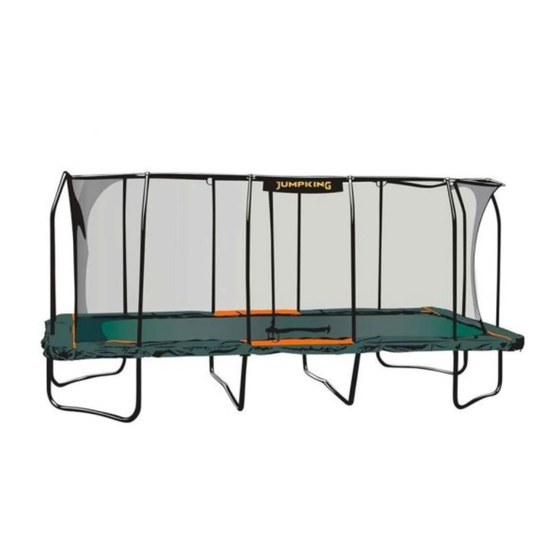
Advertisement
Quick Links
User Guide
Please scan QR code
for assemble trampoline
10ft x 18ft Rectangle
Trampoline and Enclosure
Model: JKRC1018HEC3V2
The trampoline / enclosure is internally tested up to 400lbs (181kg) or less
Got a Problem building your trampoline?
Please contact us at contact@jumpking.com or review assemble video
https://youtu.be/xbp-0PIdfWc
Jumpking
3970 Lindbergh Drive Addison, TX 75001
®
Advertisement

Summary of Contents for Jumpking JKRC1018HEC3V2
- Page 1 Trampoline and Enclosure Model: JKRC1018HEC3V2 The trampoline / enclosure is internally tested up to 400lbs (181kg) or less Got a Problem building your trampoline? Please contact us at contact@jumpking.com or review assemble video https://youtu.be/xbp-0PIdfWc Jumpking 3970 Lindbergh Drive Addison, TX 75001...
- Page 2 10ft x 18ft Rectangle Trampoline and Enclosure Model: JKRC1018HEC3V2 IMPORTANT PRECAUTIONS ......
- Page 6 While keeping the head erect, focus eyes on the trampoline toward the perimeter. For Equipment Information, Contact: YJ USA Corp., 3970 Lindbergh Drive Addison, TX75001. Website : contact@jumpking.com . Monday - Friday , 9 a.m. - 5 p.m. Model : JKRC1018HEC3V2 For Equipment Information, Contact: YJ USA Corp., 3970 Lindbergh Drive Addison, TX75001.
- Page 10 This trampoline is internally tested up to 400lbs (181kg) or less.
- Page 15 URL for Assembly Video https://youtu.be/xbp-0PIdfWc BUILDING YOUR TRAMPOLINE 1. This is a 2 person build. 2. Time for build is approximately 2 hours. 3. Choose a good location: (wood chippings, sand or grass). (7.3m) from ground level, away from wires, trees and other possible hazards. (2.5m) around sides, away from walls, fences, structures, roads and other hard surfaces and play areas.
- Page 70 This trampoline is internally tested up to 400lbs (181kg) or less. (1) Missing, improperly positioned, or insecurely attached barrier or enclosure support system (frame) padding and pole caps. (2) Punctures, frays, tears, or holes worn in the barrier or support system (frame) padding. (3) Deterioration in the stitching or fabric of the barrier or support system (frame) padding.












Need help?
Do you have a question about the JKRC1018HEC3V2 and is the answer not in the manual?
Questions and answers